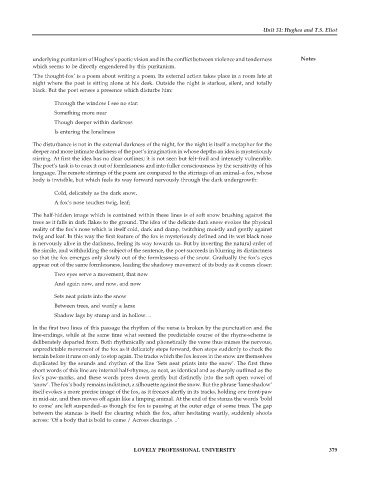Page 386 - DENG405_BRITISH_POETRY
P. 386
Unit 31: Hughes and T.S. Eliot
underlying puritanism of Hughes’s poetic vision and in the conflict between violence and tenderness Notes
which seems to be directly engendered by this puritanism.
‘The thought-fox’ is a poem about writing a poem. Its external action takes place in a room late at
night where the poet is sitting alone at his desk. Outside the night is starless, silent, and totally
black. But the poet senses a presence which disturbs him:
Through the window I see no star:
Something more near
Though deeper within darkness
Is entering the loneliness
The disturbance is not in the external darkness of the night, for the night is itself a metaphor for the
deeper and more intimate darkness of the poet’s imagination in whose depths an idea is mysteriously
stirring. At first the idea has no clear outlines; it is not seen but felt–frail and intensely vulnerable.
The poet’s task is to coax it out of formlessness and into fuller consciousness by the sensitivity of his
language. The remote stirrings of the poem are compared to the stirrings of an animal–a fox, whose
body is invisible, but which feels its way forward nervously through the dark undergrowth:
Cold, delicately as the dark snow,
A fox’s nose touches twig, leaf;
The half-hidden image which is contained within these lines is of soft snow brushing against the
trees as it falls in dark flakes to the ground. The idea of the delicate dark snow evokes the physical
reality of the fox’s nose which is itself cold, dark and damp, twitching moistly and gently against
twig and leaf. In this way the first feature of the fox is mysteriously defined and its wet black nose
is nervously alive in the darkness, feeling its way towards us. But by inverting the natural order of
the simile, and withholding the subject of the sentence, the poet succeeds in blurring its distinctness
so that the fox emerges only slowly out of the formlessness of the snow. Gradually the fox’s eyes
appear out of the same formlessness, leading the shadowy movement of its body as it comes closer:
Two eyes serve a movement, that now
And again now, and now, and now
Sets neat prints into the snow
Between trees, and warily a lame
Shadow lags by stump and in hollow. ..
In the first two lines of this passage the rhythm of the verse is broken by the punctuation and the
line-endings, while at the same time what seemed the predictable course of the rhyme-scheme is
deliberately departed from. Both rhythmically and phonetically the verse thus mimes the nervous,
unpredictable movement of the fox as it delicately steps forward, then stops suddenly to check the
terrain before it runs on only to stop again. The tracks which the fox leaves in the snow are themselves
duplicated by the sounds and rhythm of the line ‘Sets neat prints into the snow’. The first three
short words of this line are internal half-rhymes, as neat, as identical and as sharply outlined as the
fox’s paw-marks, and these words press down gently but distinctly into the soft open vowel of
‘snow’. The fox’s body remains indistinct, a silhouette against the snow. But the phrase ‘lame shadow’
itself evokes a more precise image of the fox, as it freezes alertly in its tracks, holding one front-paw
in mid-air, and then moves off again like a limping animal. At the end of the stanza the words ‘bold
to come’ are left suspended–as though the fox is pausing at the outer edge of some trees. The gap
between the stanzas is itself the clearing which the fox, after hesitating warily, suddenly shoots
across: ‘Of a body that is bold to come / Across clearings. ..’
LOVELY PROFESSIONAL UNIVERSITY 379

